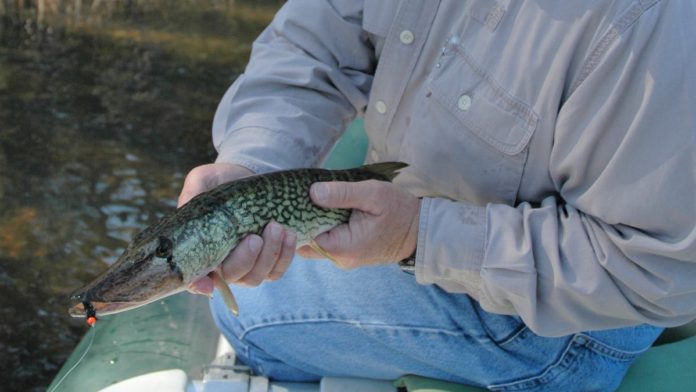The week before the Super Bowl can be a tough one for folks in this part of the world, especially if you are a long suffering Dallas Cowboys fan.
There is also precious little to do in the outdoors world right now if you live around Texomaland. Deer season is over, duck season winds down this weekend, it’s still weeks until spring turkey season starts, and the best bass fishing — even for pre-spawn lunkers prowling about in late winter — remains just around the corner.
My longtime friend Rob Woodruff, the Orvis endorsed guide who has led anglers on fly rod quests for big bass in East Texas, trout in cold waters from Oklahoma to Montana, and tarpon and permit on saltwater flats in Belize, currently lives in the Tyler area with his wife Jenny.
And despite his extensive fishing resume across Texas and other parts of the angling world, Rob agrees that from a fishing standpoint, pickings are kind of slim right now.
“Late winter offers few choices to fly fishermen in our part of the world,” notes my friend in a Woodruff Guide Service newsletter I rediscovered the other day. “Trips to tail waters in Oklahoma, New Mexico and Arkansas, pursuing winter put and take trout and checking out rumors of the start of the sand bass runs comprise most of the on the water opportunities.”
But Woodruff says all angling hope isn’t lost right now, especially for one of the Lone Star State’s least known freshwater fish species.
“(There) is one prime target that goes overlooked at this time of year,” Woodruff notes in his newsletter. “A fish that pursues flies in shallow water, hits hard, fights hard and even jumps on occasion — the chain pickerel.”
If that species seems unfamiliar here in North Texas, it’s because you’ll have to travel a few miles east of here to find a piscatorial critter that looks like a smaller version of a northern pike. Woodruff says that the fish, also known as a jackfish to some anglers, has a native range that is basically found in the eastern half of the U.S.
The Texas Parks and Wildlife Department website confirms that too, noting that chain pickerel typically reside from Canada south to Florida. Basically, any U.S. state east of the Mississippi and from the Canadian border south to the Gulf Coast is prime territory where chain pickerel can be found.
Closer to home, the species also bleeds over from Arkansas and Louisiana waters into river drainages and lakes found in the Pineywoods of East Texas. In general, Woodruff says that Lone Star State anglers will typically find the fish in waters lying generally to the east of I-45.
My own personal experience with chain pickerel is limited, but I have found fly fishing success with Woodruff on a couple of trips to Daingerfield State Park and while bass fishing around Caddo Lake. Other East Texas waters where you might find chain pickerel include Pat Mayse, Hawkins, Lake o’ the Pines, Raven, and Toledo Bend to name a few.
As noted above, chain pickerel are similar to northern pike in looks, as well as in how hard they hit a lure and how hard they fight their way back to the boat. But they are much smaller than northern pike, topping out below the 10-pound mark across their range.
The International Game Fish Association’s long standing world record for the specimen is a 9-pound, 6-ounce bruiser pulled from a water body near Homerville, Ga. back in February 1961. In Texas, the chain pickerel state record comes from Pat Mayse Lake in Lamar County, a 4.75-pound fish caught on Feb. 18, 1996 by Robert Finch.
Other sizable jackfish include a near state record, a 4.63-pound specimen pulled from Caddo Lake on June 12, 1986 by Deborah Morris and a 3.20-pound fly rod specimen, also from Caddo. Incidentally, that fly rod chain pickerel from Caddo was caught by Cliff Hilbert on Dec. 24, 2003, a fish that is the Texas fly rod state record for the species.
A more reasonable weight to expect is in the 1-2 pound range, a size that is found readily in most of the East Texas waters where chain pickerel swim. Those fish should provide some good angling opportunity between now and the end of next month since TPWD says that chain pickerel spawn in Texas between December and February.
While jackfish can be caught at other times of the year in deeper water, now is the time when the fish push shallow to deposit strings of sticky eggs on aquatic vegetation where they will be subsequently fertilized and further the species for another year.
Interested in giving chain pickerel a try over the next month when little else is happening in the Texas outdoors world? If you’re into fly rods like Woodruff and yours truly are, Rob gives solid advice. For starters, he says to think lightweight fly rods, something in the 3-weight or 4-weight range, the same kind of setup that many anglers use for trout and bluegills.
When it comes to fly lines, Woodruff mostly uses a floating line although he will sometimes switch to a sink tip if the fish are deeper. As for leaders and tippets, he says to remember the business end of a chain pickerel and choose accordingly.
“Like their cousins the northern pike and muskellunge, pickerel are well equipped in the dental department,” said Woodruff. “A pair of long forceps or a Ketchum Release is a must have item for releasing the pickerel.
“If you choose to use your fingers, pack a first aid kit,” he adds. “Although some books advise the use of wire leaders, I have found that 2x or 3x tippet along with fastidious checking of leaders and knots is the best choice. Make it a habit to check your leader for fraying after every fish landed and every strike missed.”
What about flies when targeting East Texas’ jackfish?
“Top flies for pickerel are streamers and poppers,” notes Woodruff. “Streamers or poppers in white, chartreuse, yellow and silver (and combinations thereof) work well most days, but on some days the fish seem to prefer darker colors like black, olive and purple.”
If you’re a conventional tackle fishing enthusiast, think lightweight spinning gear, monofilament line in the 6- to 10-lb. test range, and small flashy lures in the color schemes mentioned above. If memory serves correct, my success near Caddo Lake was on a small chartreuse and white spinnerbait that drew multiple viscous strikes.
What tactics should you use for East Texas’ chain pickerel? Woodruff says that depends on the weather and the time of day being fished. When the light is low early, late, and on cloudy days, chain pickerel can be found in very shallow water in grassy coves and along shoreline flats.
During the late morning, midday, and afternoon hours on brighter days, target shady spots near lily pad fields, shoreline trees, and drop-offs and breaklines near deeper water, especially locations with some vegetation hanging around.
All in all, there’s much to like about one of the lesser known and rarely appreciated piscatorial critters swimming in Pineywoods waters, even if they don’t get that big.
While a good sized East Texas chain pickerel might not provide the same excitement that a 13-pound largemouth from the region does, the species is still a lot of fun to target in the late winter.
After all, they hit lures and flies hard, fight like pint-sized demons, and give an angler a good excuse to get out on the water.
Even if the Cowboys and all of their fans will be watching the Super Bowl from the sidelines again. Oh well, might as well get out and go fishing!
Credit: Source link






























